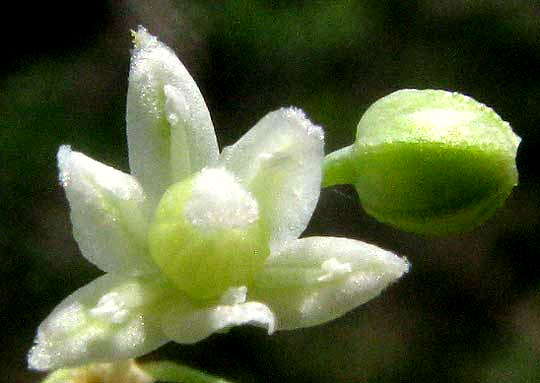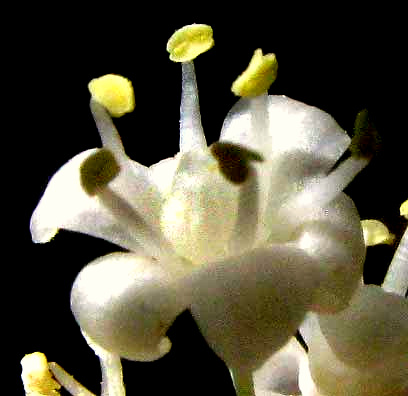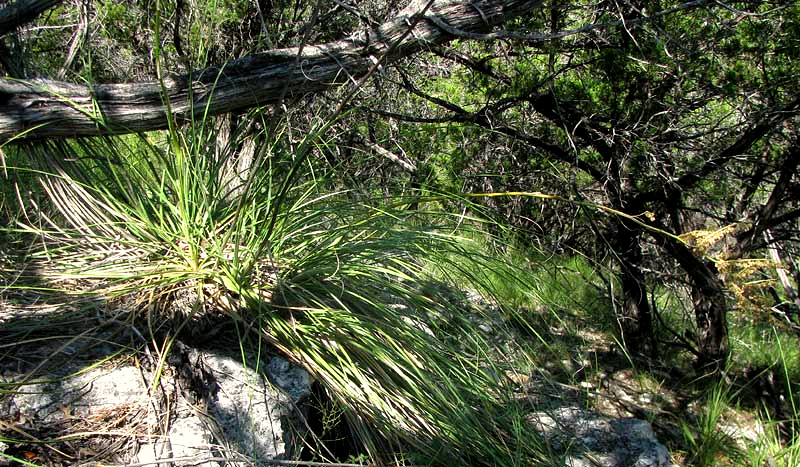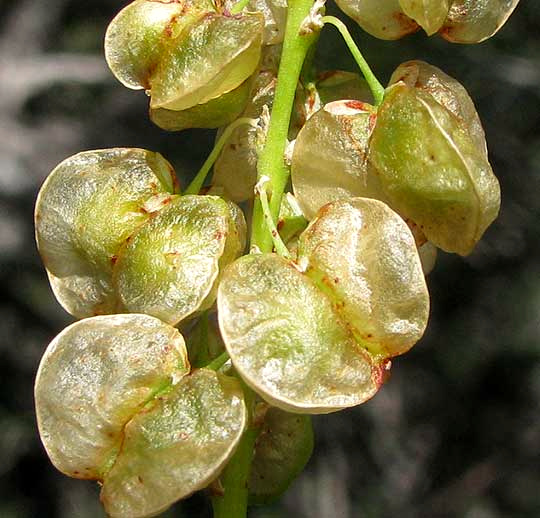Excerpts from Jim Conrad's
Naturalist Newsletter

from the June 23, 2013 Newsletter issued from the Frio Canyon Nature Education Center in the valley of the Dry Frio River in northern Uvalde County, southwestern Texas, on the southern border of the Edwards Plateau; elevation ~1750m (~5750 ft); N29.62°, W99.86°; USA
DEVIL'S SHOESTRING FLOWERING
Within a stone's toss from my sleeping window in the Center there are the noble-looking, tufted plants with tough, finely toothed leaves and flowering heads reaching 6½ feet high
(2m) shown above.
This is an endemic species found naturally only in a few counties here in southwestern Texas. It's NOLINA LINDHEIMERIANA, among whose common names are Devil's Shoestring, Ribbon Grass and Lindheimer's Beargrass.

Above you can see a flower from my sleeping-window plant. It's 3/16th-inch wide and opposite each of its six tepals -- a tepal being a "petal" not clearly either the calyx or corolla -- arises a stamen. In the flower's center is an oval ovary topped with a fuzzy, three-lobed stigma.
Species in the genus Nolina produce functionally unisexual flowers, so I was surprised to see in the above blossom both well developed stamens and a plump ovary. However, on a smaller plant next to the one producing the flower in the picture, the flowers bore stamens much more developed than in the above picture, as you can see below:

Therefore, despite both blossoms bearing both male and female parts, the first one we looked at was functionally female while the second was functionally male.
Sometimes during these full-moon nights I rise from my sleeping spot on the Center's floor and look through the window at the ghostly pale flower clusters of the Devil's Shoestrings rising just a few feet away, and I feel very good, very happy to live next to such exalted beings.

from the the September 16, 2012 Newsletter issued from the valley of the Dry Frio River in northern Uvalde County, southwestern Texas, on the southern border of the Edwards Plateau; elevation ~1750m (~5750 ft); N29.62°, W99.86°; USA
DEVIL'S SHOESTRING
Beneath scrubby Ashe Junipers at the edge of a limestone ledge on the hill facing the cabin a dense, bathtub-size clump of slender, yard-long (1m) leaves sprouted from a rock fissure. Arising from the center of the leaves a spindly stem topped with a cluster of small fruits arced toward the valley directly below, as shown above. The fruits surprised me, for they were inflated, three-cornered capsules, as shown below:

The grasslike leaves, only about 3/8ths inch wide (1cm) bore tiny saw-teeth, seen below:

I'd seen plants similar to this before, though different. You might remember the one found back in 2007 similarly perched on a limestone cliff high in the Eastern Sierra Madres of Querétaro, Mexico, but with a trunk, still shown at http://www.backyardnature.net/n/07/070119no.jpg.
Often these plants are known as beargrasses. They're the genus Nolina normally placed in the Agave Family, and the online Flora of North America says that about 30 species are known, of which 14 occur in the US, mostly in the Southwest but also in the Southeast. Ours keys out to NOLINA LINDHEIMERIANA, among whose common names are Devil's Shoestring, Ribbon Grass and Lindheimer's Beargrass.
This is a wonderful find, for the species is endemic to only a few counties here in southwestern Texas. Though it's common on limestone outcrops on this side of the hill (the other side has been "cleared" for cattle) the Flora of North America says that it is "quite infrequent and becoming more so as its habitat is destroyed through development or overgrazing."